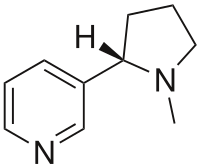
Photo from wikipedia
We present an overview of the toxicological profile of the fast‐acting, lipophilic macrocyclic imine toxins, an emerging family of organic compounds associated with algal blooms, shellfish contamination and neurotoxicity. Worldwide,… Click to show full abstract
We present an overview of the toxicological profile of the fast‐acting, lipophilic macrocyclic imine toxins, an emerging family of organic compounds associated with algal blooms, shellfish contamination and neurotoxicity. Worldwide, shellfish contamination incidents are expanding; therefore, the significance of these toxins for the shellfish food industry deserves further study. Emphasis is directed to the dinoflagellate species involved in their production, their chemical structures, and their specific mode of interaction with their principal natural molecular targets, the nicotinic acetylcholine receptors, or with the soluble acetylcholine‐binding protein, used as a surrogate receptor model. The dinoflagellates Karenia selliformis and Alexandrium ostenfeldii / A. peruvianum have been implicated in the biosynthesis of gymnodimines and spirolides, while Vulcanodinium rugosum is the producer of pinnatoxins and portimine. The cyclic imine toxins are characterized by a macrocyclic skeleton comprising 14–27 carbon atoms, flanked by two conserved moieties, the cyclic imine and the spiroketal ring system. These phycotoxins generally display high affinity and broad specificity for the muscle type and neuronal nicotinic acetylcholine receptors, a feature consistent with their binding site at the receptor subunit interfaces, composed of residues highly conserved among all nAChRs, and explaining the diverse toxicity among animal species.
Journal Title: Journal of Neurochemistry
Year Published: 2017
Link to full text (if available)
Share on Social Media: Sign Up to like & get
recommendations!